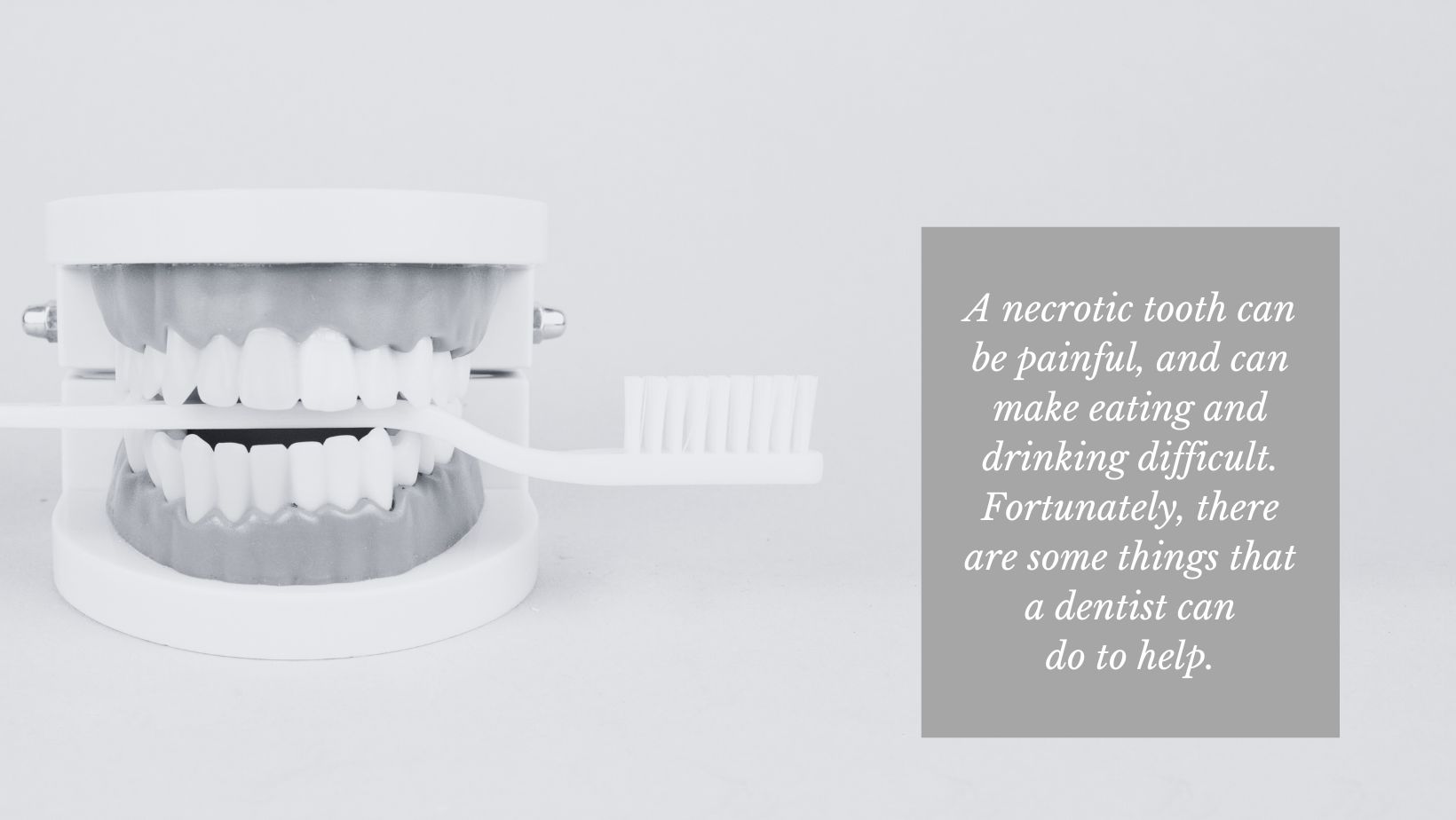Have you been diagnosed with dental necrosis? This is a condition where the pulp tissue inside of a tooth dies. (It might also be called a necrotic tooth, which just means a “dead” tooth.) Signs that you might be experiencing dental necrosis include pain when biting down or sensitivity to hot or cold foods.
A necrotic tooth is the last step before possibly losing that tooth. Although the diagnosis can be daunting, there are safe and (relatively) painless treatments that can save your tooth and prevent further issues.
What is Dental Necrosis? And How Does it Happen?
The death of a tooth does not come all at once. There are several stages that occur before a tooth becomes necrotic.
Tooth decay begins when acids and bacteria build up, creating plaque. Plaque is a sticky film that develops on teeth. If not removed in a timely fashion, the build-up of plaque can lead to a cavity— a hole in a tooth’s enamel. That hole can leave the dentin exposed and vulnerable to infect the pulp chamber. The pulp chamber is found at the center of the tooth and is made up of nerves and blood vessels. It is sometimes referred to as the “root” of the tooth.
Pulpitis occurs when bacteria gets into a tooth’s pulp chamber, leading to an infection. This will result in pain and swelling of the healthy tooth pulp and lead to necrotic pulp.
Dental necrosis is the final stage of a tooth infection. At this stage, the tooth’s nerves and blood vessels have died. However, if caught and treated in time, there is still the possibility to reverse pulpitis and save your tooth.
Are There Treatments for Dental Necrosis?
A necrotic tooth can be painful, and can make eating and drinking difficult. Fortunately, there are some things that a dentist can do to help.
Keep in mind that, if necrotic pulp is found, simply filling the tooth will not work. Fillings are used to treat surface cavities, not issues at the root. Once the pulp becomes infected, it requires a more complex treatment.

Root Canal
Because the infection is deep within the tooth, a root canal is required to treat dental necrosis. It is true that root canals have a bad reputation. But modern root canals are pretty straight-forward, and no more painful than other dental procedures.
During a root canal, a dentist applies an anesthetic to the tooth in order to numb the site and drill down safely to the pulp chamber. This is key to treating the infection site of dental necrosis. Once at the root, a dentist removes the infected tissue and cleans out the space left behind. Medicine might also be applied to treat the area and prevent further decay. A temporary crown will be used to seal the tooth, with a permanent crown to be placed at a later date.
Extraction (“Pulling” the Tooth)
Tooth extraction is recommended for some of the same reasons as a root canal, though dentists will always do their best to save the patient’s tooth if possible. A tooth is usually pulled or extracted when pulpitis is so bad that most of the tooth is gone already.
Like root canals, tooth extraction is an outpatient procedure done under a local anesthetic. Some circumstances, such as impacted teeth or teeth broken below the gumline, may require a general anesthetic. Simple tooth extractions have few complications and are done routinely for other reasons as well (for example, impacted wisdom teeth). Recovery is similar to a root canal.
Once a tooth is extracted, it might be replaced with an implant or using a dental bridge.
Managing Pain
Until treated, a necrotic tooth is likely to be painful. The area might also be painful for some time after a root canal or extraction. There are some common ways to deal with this pain.
NSAIDs (nonsteroidal anti-inflammatory drugs) like ibuprofen or non-opioid analgesics like acetaminophen can help manage pain. Higher doses may be needed to reduce inflammation. Your dentist might give you a prescription for a higher strength form of these pain relievers.
Topical anesthetics can be applied directly to the area of toothache pain. These usually have ingredients such as benzocaine or lidocaine, and can temporarily dull pain by numbing the area.
Risks of Untreated Dental Necrosis
If dental necrosis goes untreated, it can lead to further infection and even abscesses. The infection deprives the tooth nerve of oxygen and blood flow. So, if your pain begins to subside this could be a sign of the tooth dying, which will result in the need of your tooth to be extracted. This is typically reserved as a last resort for dentists as it can lead to teeth misalignment, difficulty eating amongst other things.
Furthermore, dental necrosis can impact the rest of your teeth and overall health. The infection can spread to your jaw, sinuses, or gums and even travel to other parts of the body. A necrotic tooth can lead to discoloration, first turning the tooth yellow and over time darkening to gray, brown, or black.
Seek Treatment Sooner than Later
Maintaining good oral hygiene is a preventative measure to decrease the chance of dental necrosis and other infections. Healthy habits include regularly brushing, flossing, and rinsing your teeth. Maintaining regular dental checkups and cleanings can also help identify infections before they progress to dental necrosis. Whatever the case may be, don’t delay getting treated and getting to the root of the problem. Use our online appointment tool to find a dentist that can help.


